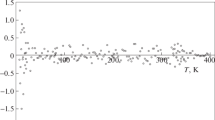Abstract
We have examined the influence which sample geometry has on the melting point of isothermally melt crystallized polyethylene. The peak positions of curves obtained using a Perkin-Elmer DSC were used as the apparent melting points (Tm). With a constant sample weight (ca. 0.05 mg), we observed an increase of 1.7 K for Tm when the sample thickness was increased from 1 to 8 μm. Experiments which demonstrate the heat transfer problems related to the melting of polymer samples are also presented. This work indicates that, if one is attempting to reduce the heating rate dependence of polymer samples, reduction of sample weight alone is not suffiicient. Rather one should aim at increasing the sample pan contact area and reducing the sample thickness simultaneously.
Zusammenfassung
Der Einfluß der Probengeometrie auf den Schmelzpunkt isotherm geschmolzenen kristallinen Polyäthylens wurde untersucht. Die Peakpositionen in den mit einem Perkin-Eimer DSC erhaltenen Diagrammen wurden als scheinbare Schmelzpunkte (Tm) benutzt. Bei konstantem Probengewicht (etwa 0.05 mg) wurde für Im ein Anstieg um 1.7 K beobachtet, wenn die Schichtdicke der Probe von 1 auf 8 μm erhöht wurde. An Experimenten werden auch die mit dem Schmelzvorgang bei Polymerproben zusammenhängenden Wärmeübergangsprobleme aufgezeigt. Diese Arbeit macht deutlich, daß eine Verminderung des Probengewichts allein zur Verminderung der Aufheizgeschwindigkeitsabhängigkeit der Polymerproben nicht ausreichend ist. Es soll vielmehr eine gleichzeitige Vergrößerung der Probenträgerkontaktfläche und Verringerung der Probenschichtdicke angestrebt werden.
Резюме
Исследовано влияние геометрии образца на точку плавления изот ермически плавленного кристал лизационного полиэт илена.
Положения пиков терм ограмм, полученных с помощью ДСК (фирмы Пе ркин-Эльмер), были использованы как каж ущиеся точки плавленияТпл. При по стоянном весе образц а (около 0.05 мг), но при увеличении е го толщины от 1 до 8 ммк, наблюдалос ь увеличениеТпл. на 1.7 К
Представлены экспер именты, показывающие пробле мы переноса тепла, свя занные с плавлением образцов полимера. Исследования показы вают, что одна попытка понизить зависимость скорост и нагрева образцов полимера од новременно уменьшая вес образца, является недостаточ ной. Скорее должна преследовать ся цель одновременно го увеличения поверхно стного контакта печи с образцом и уменьшен ие толщины образца.
Similar content being viewed by others
References
W. D. Varnell, I. R. Harrison andJ.-I. Wang, J. Polymer Sci.: Polym. Phys. Ed., 19 (1981) 1577.
I. R. Harrison andJ. Runt, J. Polymer Sci.: Polym. Phys. Ed., 17 (1979) 321.
Manual for DSC-2, Perkin Elmer Corp. Norwalk, CT. 1974.
A.Weissberger, Techniques in Organic Chemistry, Vol. 1, Part 5, Chapter 8.
G. Davis andR. Porter, J. Thermal Anal., 1 (1969) 449.
Author information
Authors and Affiliations
Additional information
The authors gratefully acknowledge the support of the National Science Foundation (Polymers Division) Grant No. DMR 78-25233.
Rights and permissions
About this article
Cite this article
Harrison, I.R., Varnell, W.D. The effect of sample geometry on the melting point of polyethylene. Journal of Thermal Analysis 25, 391–397 (1982). https://doi.org/10.1007/BF01912965
Received:
Issue Date:
DOI: https://doi.org/10.1007/BF01912965




